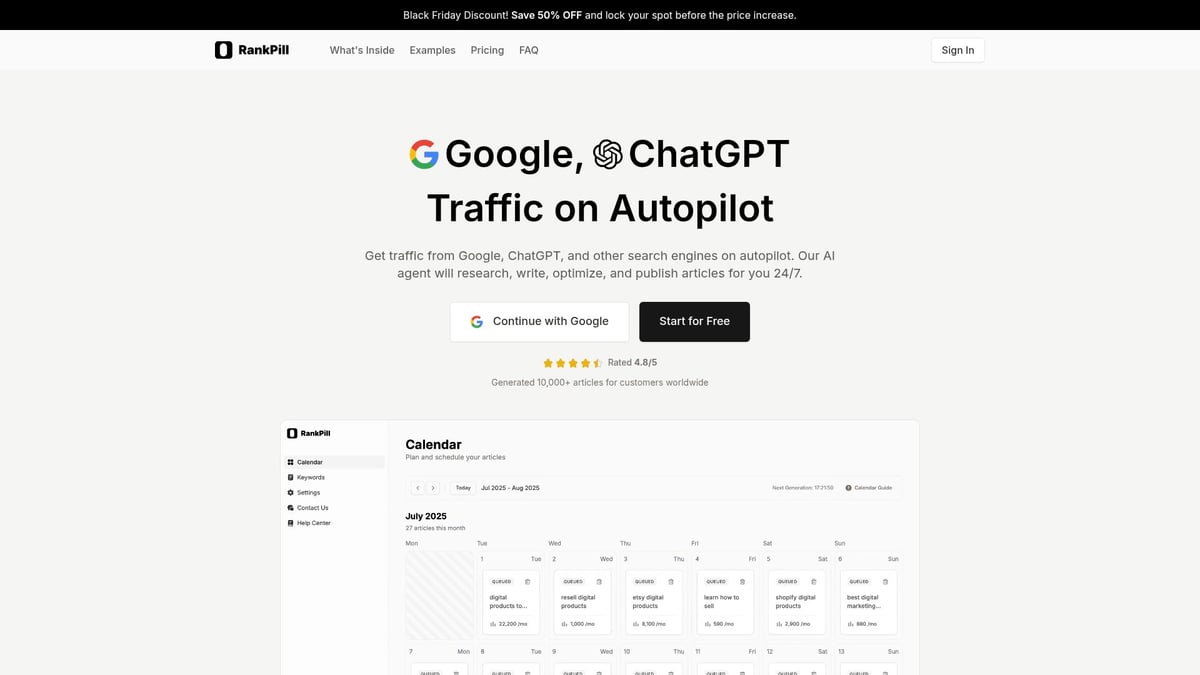Are you finding it tough to climb higher in Google search results as we approach 2025? The world of seo and keywords is shifting quickly, making it more challenging for businesses and creators to stay visible.
This essential handbook will break down the latest strategies, giving you practical, up-to-date knowledge that works now and into the future. You will learn the fundamentals, advanced keyword research, and proven tactics to help you outrank competitors.
Get ready to explore seo and keywords basics, master research, optimize your content, leverage AI tools, and get ahead of the trends shaping search in 2025.
Understanding SEO in 2025: The New Fundamentals
Staying ahead in the world of seo and keywords requires understanding how fast the landscape is changing. The fundamentals of SEO have shifted dramatically, driven by new technologies, evolving user habits, and changing search engine priorities. To succeed in 2025, you need to grasp these new essentials and adapt your strategies accordingly.

Evolution of SEO: From 2020 to 2025
The evolution of seo and keywords from 2020 to 2025 has been shaped by major Google algorithm updates. Notable examples include the Helpful Content update and the introduction of Core Web Vitals, both emphasizing user experience and content relevance.
Artificial intelligence and machine learning now play a central role in determining search rankings. Search engines increasingly prioritize E-E-A-T — Experience, Expertise, Authoritativeness, and Trustworthiness — as a core ranking signal. This shift means that generic content and keyword stuffing are no longer effective. If you want to avoid penalties, it is crucial to avoid keyword stuffing pitfalls and focus on search intent optimization.
Zero-click searches and featured snippets are more common than ever. Users often find answers directly in search results, reducing the need for clicks. Mobile-first indexing is now the standard, and voice search is on the rise. Over 60 percent of searches are now mobile, making mobile optimization essential for success with seo and keywords.
Core SEO Pillars for Modern Success
Modern seo and keywords strategies rest on four foundational pillars. Each pillar must work together to achieve top search performance.
| SEO Pillar | Focus Areas | Impact Example |
|---|---|---|
| Technical SEO | Site speed, crawlability, structured data | Fast load times boost average session by 70% |
| On-page SEO | Content quality, meta tags, headings | Strong meta tags improve click-through rates |
| Off-page SEO | Backlinks, brand mentions, social signals | Quality backlinks increase authority |
| User Experience | Load times, interactivity, core web vitals | Better UX lowers bounce rate, boosts rankings |
Technical SEO ensures your site is accessible and fast. On-page SEO prioritizes content quality, proper meta tags, and well-structured headings. Off-page SEO builds authority through backlinks and social signals. User experience, including page speed and interactivity, now directly impacts rankings. Sites with fast load times see users spend 70 percent longer on average, reflecting the importance of a holistic seo and keywords approach.
The Role of AI and Automation in SEO
AI and automation are transforming how brands approach seo and keywords. AI-driven tools now offer content recommendations, analyze competitors, and optimize for search intent automatically.
Predictive analytics help marketers spot emerging keyword trends before competitors do. Automated technical audits uncover crawl issues and suggest fixes in real time. In fact, AI platforms now generate 30 percent of all new web content, demonstrating the growing impact of automation on seo and keywords strategies.
Embracing these tools allows you to work smarter, not harder. By integrating AI and automation, you can streamline repetitive tasks, focus on high-impact activities, and stay ahead as search engine algorithms continue to evolve.
Keyword Research Mastery: Finding and Targeting the Right Terms
Unlocking the power of seo and keywords starts with understanding how searchers think and what they truly want. In this section, you will learn how to identify intent, deploy advanced research techniques, evaluate keyword opportunities, and build a data-driven keyword list that delivers results.

Step 1: Understanding Searcher Intent in 2025
Knowing why users search is the heart of effective seo and keywords strategies. Today’s search engines decode not just the words, but the meaning behind every query.
There are four main types of search intent:
- Informational: Users want to learn something (“How to optimize a website”)
- Navigational: Users seek a specific site or page (“Google Analytics login”)
- Transactional: Users are ready to buy (“Buy noise-canceling headphones”)
- Commercial: Users compare options (“Best laptops 2025”)
Mapping keywords to each stage of the user journey ensures your content meets their needs. For example, “Best running shoes 2025” signals research, while “Buy Nike Air Zoom online” is purchase-focused. According to Moz, 80% of queries are informational or research-based, highlighting the importance of aligning your seo and keywords approach to intent.
Step 2: Advanced Keyword Research Techniques
To stay ahead in seo and keywords, leverage cutting-edge tools and methods. AI-powered platforms now analyze competitor keywords, uncover hidden long-tail phrases, and spot semantic opportunities at scale.
Key techniques include:
- Using AI tools to dissect competitor rankings
- Identifying long-tail and semantic keywords for precise targeting
- Analyzing SERP features and People Also Ask boxes for fresh ideas
- Leveraging Google Trends and predictive search data to track shifts
Popular platforms such as SEMrush, Ahrefs, and Google Keyword Planner streamline this process. For a deeper dive into these methods, see these advanced keyword research techniques. Integrating these strategies into your seo and keywords workflow uncovers high-impact opportunities others might miss.
Step 3: Assessing Keyword Difficulty and Opportunity
Not all keywords offer equal value. Evaluating search volume against competition is crucial for effective seo and keywords planning.
Focus on these steps:
- Compare monthly search volume with keyword difficulty scores
- Identify “quick win” keywords with low competition and moderate demand
- Prioritize keywords that align with your business goals and fill content gaps
Consider this: 92% of keywords receive ten or fewer monthly searches, according to Ahrefs. This means targeted, low-competition phrases can drive incremental growth for your seo and keywords efforts.
Step 4: Building a Winning Keyword List
A structured keyword list is your roadmap to seo and keywords success. Start by clustering terms based on topic and intent, then build pillar and cluster content strategies around these groups.
A sample workflow:
- Group keywords by semantic similarity and user intent
- Design pillar pages for broad topics (e.g., “SEO tools”), with supporting cluster content (e.g., “on-page optimization”)
- Organize keywords into a content calendar for consistent publishing
This approach ensures comprehensive coverage and maximizes your visibility across search journeys. With a strategic seo and keywords plan, your site becomes an authority in its niche.
Content Optimization: Turning Keywords into Ranking Power
Optimizing your content is essential if you want to transform seo and keywords into tangible search engine rankings. Modern SEO is not just about sprinkling keywords but about creating value, structure, and a seamless experience for users. Each element, from your headlines to your visuals, plays a critical role in unlocking higher visibility and engagement.

On-Page SEO Best Practices for 2025
To turn seo and keywords into real ranking power, start with the essentials of on-page optimization. Prioritize compelling title tags, concise meta descriptions, and strategic header tags. Ensure that your primary and secondary keywords appear naturally throughout your content, especially within the introduction and headings.
Use optimized images with descriptive alt text and relevant file names to enhance both accessibility and SEO. Structured data should be implemented to help search engines interpret your page context. According to Backlinko, pages with optimized images rank 25% higher, making visual optimization a must.
For a step-by-step approach to structuring content and deploying seo and keywords effectively, explore Building SEO content strategies. By following these best practices, you lay a strong foundation for higher rankings, improved click-through rates, and increased authority in your niche.
Semantic SEO and Topical Authority
Achieving topical authority in 2025 requires more than just targeting primary seo and keywords. Instead, focus on related terms, entities, and comprehensive coverage of your subject. Search engines now reward content that demonstrates depth and context, not just keyword frequency.
Build semantic relevance by using synonyms, answering People Also Ask questions, and linking to related internal resources. Top-ranking pages typically cover their topics 40% more comprehensively, according to SEMrush. This approach ensures your content aligns with user intent while signaling expertise and trustworthiness.
By leveraging semantic SEO, you empower your pages to rank for a broader set of queries, reinforcing your authority and visibility.
User Experience and Engagement Signals
User engagement is now central to successful seo and keywords strategies. Optimize your site for readability by using short paragraphs, bullet points, and clear calls to action. Mobile usability is non-negotiable, as over 60% of searches are now performed on mobile devices.
Multimedia elements such as images, videos, and infographics can significantly boost engagement. Wistia reports that video content increases time on page by 88%. Reducing bounce rates and increasing session duration are strong signals to search engines that your content is valuable.
Always ensure your content loads quickly, is easy to navigate, and keeps visitors interacting with your site.
Monitoring and Updating Content for Ongoing Success
Continuous improvement is the backbone of sustainable seo and keywords performance. Use analytics tools to track keyword rankings, organic traffic, and user behavior. Regularly revisit your top-performing pages to refresh outdated information, add new insights, and re-optimize for emerging keywords.
Establish a content calendar that schedules periodic reviews and updates. HubSpot notes that pages updated frequently see three times more organic traffic. This proactive approach ensures your content remains relevant and maintains its ranking power.
By embedding monitoring and updates into your workflow, you create a feedback loop that drives ongoing SEO growth and resilience.
Leveraging AI and Automation for SEO Success
Artificial intelligence and automation are reshaping how marketers approach seo and keywords. In 2025, staying ahead means leveraging smart tools that streamline workflows and enhance every facet of SEO strategy.
The Rise of AI-Powered SEO Tools
AI-powered SEO platforms are rapidly transforming the landscape of seo and keywords management. These tools use machine learning to analyze search trends, user intent, and competitor strategies at scale.
Modern platforms can suggest keyword opportunities, optimize content structure, and even forecast shifts in search demand. By automating data analysis, marketers gain deeper insights that would be difficult to uncover manually.
Many AI tools now offer real-time recommendations for on-page improvements and can generate content outlines tailored to specific audiences. This means teams can focus more on strategy and less on repetitive research, leading to faster and more effective SEO campaigns.
Automating Repetitive SEO Tasks
Automation is vital for handling the routine aspects of seo and keywords optimization. Tasks like site audits, technical fixes, and meta tag updates can be managed efficiently with AI-driven solutions.
For example, bulk optimization of images and meta descriptions ensures that every page is search-friendly without manual intervention. Scheduling and auto-publishing content also reduces bottlenecks in the content pipeline.
Marketers using automation report significantly faster content deployment and improved consistency across their digital assets. This approach frees up valuable time to focus on higher-level planning and creative work, enhancing the overall SEO process.
How AI Platforms Like RankPill Transform SEO Content Creation
Platforms such as RankPill are redefining how businesses approach seo and keywords. These AI-powered solutions automate keyword research, competitor analysis, and even content writing, allowing marketers to scale their efforts without increasing headcount.

RankPill offers personalized keyword targeting, generates content calendars, and integrates seamlessly with popular CMS platforms for effortless publishing. It also automates the insertion of images, videos, and internal links, ensuring comprehensive optimization.
To learn more about how AI is revolutionizing seo and keywords, check out Using AI for SEO and keywords. Many businesses now rely on these tools for cost-effective, scalable SEO, often replacing traditional agencies for ongoing optimization.
Choosing the Right AI Tools for Your Needs
Selecting the best AI solution for seo and keywords starts with evaluating features and integrations. Consider whether the platform supports multi-language projects and local SEO, which are increasingly important in a global market.
Look for tools that offer real-time optimization, actionable insights, and the ability to automate both technical and content-related tasks. Scalability is key, especially as your site and content needs grow.
Finally, ensure the platform aligns with your business objectives and can adapt to future SEO trends. By making informed choices now, you position your brand for ongoing search success.
Future-Proofing Your SEO Strategy: Trends and Predictions for 2025
Staying ahead with your seo and keywords strategy means anticipating not just the next algorithm update but the next shift in how users search and engage online. As 2025 approaches, future-proofing your approach is essential for long-term visibility and authority.
Search Engine Evolution: What’s Next?
Search engines are evolving rapidly, with Google at the forefront of major changes. Anticipate updates that prioritize user intent and high-quality content, driven by advancements in artificial intelligence and machine learning. Visual, voice, and video search are expected to play larger roles, with voice search projected to account for 50% of all queries by 2025. The seo and keywords landscape is also shaped by the rise of AI-powered tools, making adaptability vital.
The SEO industry itself is expanding, with the SEO market projected to reach $106.15 billion by 2030. This underscores the importance of staying informed about trends like mobile optimization, AI integration, and the growing demand for seamless user experiences.
The Role of Personalization and User Data
Personalization is taking center stage in seo and keywords strategies. Search engines are leveraging user data to deliver more tailored results, making it critical for brands to understand their audience’s behaviors and preferences. Customizing content based on first-party data can improve engagement and relevance.
For example, personalized content increases user engagement by 42 percent, according to Econsultancy. To future-proof your approach, analyze data from your audience’s interactions, segment users by intent, and craft unique experiences for each group. This ensures your seo and keywords efforts align with what users are actually searching for.
Building Authority and Trust in a Crowded Market
Establishing authority and trust is more important than ever as competition in search intensifies. Google’s E-E-A-T framework—Experience, Expertise, Authoritativeness, Trustworthiness—remains a key factor in ranking. To elevate your seo and keywords strategy, focus on publishing expert-driven content, adding detailed author bios, and citing reputable sources.
Earning high-quality backlinks and positive brand mentions also boosts your credibility. Brands that invest in E-E-A-T often see 30 percent higher ranking stability, making it a cornerstone for sustainable SEO success. Regularly audit your site’s authority signals and refine your approach to stand out in a crowded digital landscape.
Preparing for AI-Driven Search and Content Discovery
AI-driven platforms are reshaping how users discover information. Zero-click searches, AI-generated answers, and knowledge panels are becoming the norm. To adapt your seo and keywords strategy, structure your data for rich snippets and optimize content for platforms like ChatGPT and Gemini.
Despite the surge in generative AI, 99% of generative AI users still rely on Google Search, highlighting the ongoing need for traditional SEO best practices. Focus on concise, well-structured content that answers questions directly, making it easier for AI and search engines to understand and present your information to users.
Measuring SEO Success: Analytics, KPIs, and Continuous Improvement
Tracking the effectiveness of your seo and keywords strategy requires clear metrics and ongoing evaluation. As the digital landscape grows more competitive, knowing what to measure and how to interpret data is crucial for sustained growth.
Setting and Tracking Key SEO Metrics
Success in seo and keywords starts with identifying the right KPIs. Focus on organic traffic, keyword rankings, click-through rates (CTR), and conversion rates. These metrics directly reflect your search visibility and business impact.
According to BrightEdge, 53% of website traffic is attributed to organic search. Monitoring these numbers helps you spot growth opportunities and areas needing improvement.
Given the evolving search landscape, especially as Google's global search market share dipped below 90% for the first time since 2015, tracking your performance across multiple search engines is more important than ever.
Using Google Analytics, Search Console, and Third-Party Tools
Leverage Google Analytics and Search Console to monitor site health, keyword positions, and user interactions. These platforms provide actionable insights for your seo and keywords efforts.
Third-party tools like SEMrush or Ahrefs offer competitor analysis and advanced reporting. Use dashboards to track mobile performance, considering that over 60% of global searches are now done on mobile devices.
Regular review of these tools keeps your strategy informed and adaptable.
Continuous Optimization and A/B Testing
SEO is never static. A/B testing meta descriptions, page titles, and calls-to-action can reveal what resonates best. Use data from your seo and keywords campaigns to guide these experiments.
Iterative improvements based on results can increase CTR by up to 20%, according to HubSpot. Always document changes and track their impact to refine your approach over time.
Frequent testing ensures your content stays relevant and competitive.
Building a Feedback Loop for Ongoing SEO Growth
Establish a feedback loop by integrating analytics insights into your content strategy. Meet regularly with your marketing, content, and technical teams to review performance and adjust priorities.
Update your seo and keywords lists as trends shift, and refresh content to align with new goals. This process fosters continuous learning and adaptation.
A robust feedback loop is essential for long-term SEO growth and maintaining your edge in a dynamic environment.
As we’ve explored, mastering SEO and keyword strategies for 2025 means adapting to evolving search algorithms, embracing automation, and consistently optimizing your content. If you’re ready to put these insights into action and want a smarter, faster way to grow your organic traffic, I encourage you to see how AI-powered tools can transform your workflow. With platforms like RankPill, you can automate content creation, streamline keyword research, and stay ahead of competitors—all while saving time and resources. If you’re looking to simplify your SEO journey and achieve measurable results, Get Started.